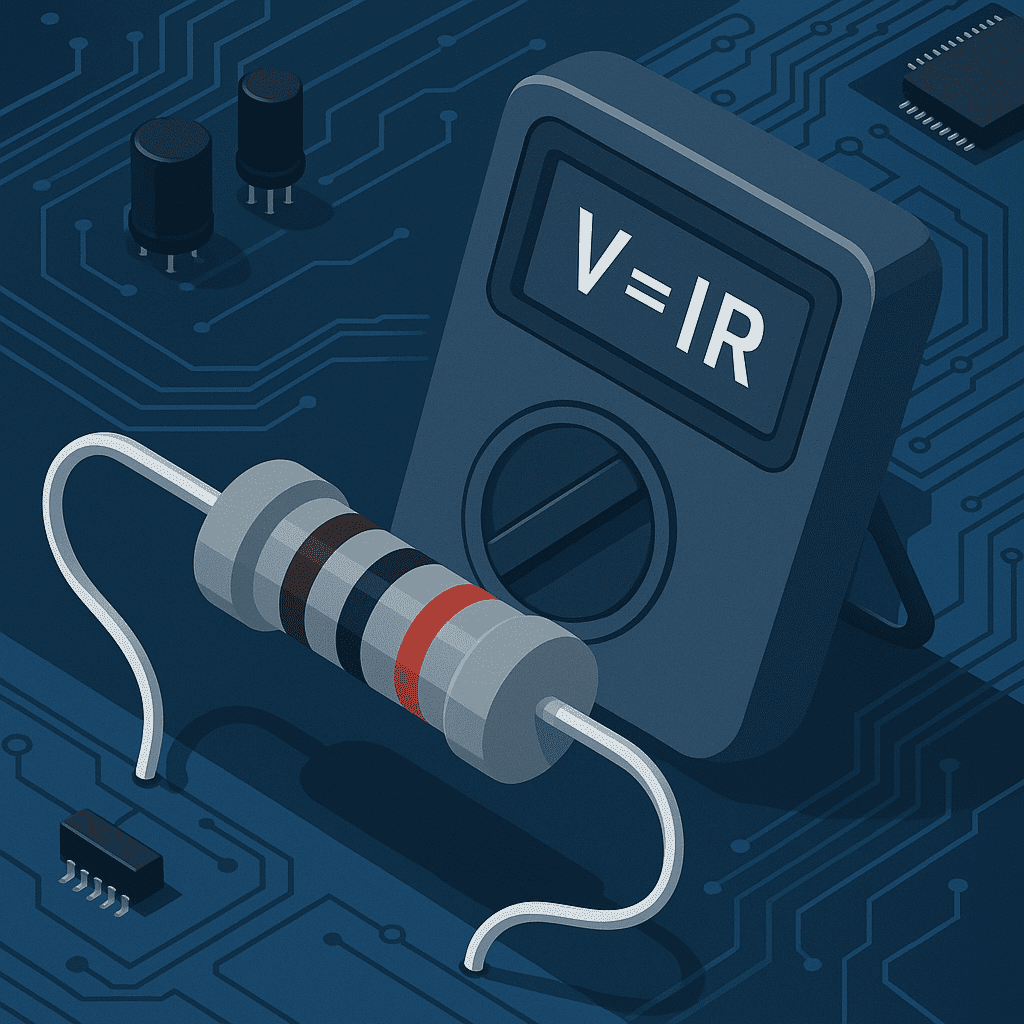Fundamentals of Voltage, Current, and Resistance (Ohm’s Law)

Fundamentals of Voltage, Current, and Resistance (Ohm’s Law) , Electricity is a fundamental force that powers the modern world, enabling everything from simple household gadgets to complex industrial machinery. At the heart of understanding electronics lie three essential concepts: voltage, current, and resistance. These three elements are interconnected through Ohm’s Law, a cornerstone of electrical engineering. In this article, we’ll break down each component, explore their relationships, and provide practical examples to solidify your understanding.
What is Voltage?
Voltage, often referred to as electric potential difference, is the force or pressure that drives electric charges through a conductor. It’s measured in volts (V) and represents the energy per unit charge available to move electrons from one point to another in an electrical circuit. In essence, voltage can be thought of as the electrical pressure pushing electrons through a wire, similar to the water pressure that drives water through a pipe.
Real-World Analogy for Voltage
Imagine a water tank on a hill. The higher the tank, the greater the pressure at the bottom when the water is released. This pressure forces the water to flow through pipes, much like how electrical voltage pushes electrons through a wire.
Practical Example of Voltage
Consider a 9-volt battery connected to a small DC motor. The 9V battery provides the electric pressure needed to push current through the motor, allowing it to spin. Without this pressure, the motor wouldn’t move, just like water won’t flow without pressure.
What is Current?
Current is the flow of electric charge in a circuit, measured in amperes (A). It represents the number of electrons passing a specific point in the circuit per second. Unlike voltage, which can exist without current, current only flows when there is a complete path for electrons to move through.
Key Characteristics of Electric Current:
- Direct Current (DC) – Flows in a single direction (e.g., batteries).
- Alternating Current (AC) – Flows back and forth in cycles (e.g., household power outlets).
Practical Example of Current
When you plug a light bulb into a socket, the current flows through the filament, heating it up and producing light. If the current is too high, the bulb can burn out, emphasizing the importance of matching current capacity with the device.
What is Resistance?
Resistance is the opposition that a material offers to the flow of electric current. It’s measured in ohms (Ω) and depends on the material’s composition, length, thickness, and temperature. Resistance slows down the flow of electrons, converting some electrical energy into heat in the process.
Factors Affecting Resistance:
- Material Type – Conductors like copper have low resistance, while insulators like rubber have high resistance.
- Length of the Conductor – Longer wires have more resistance.
- Cross-Sectional Area – Thicker wires have less resistance.
- Temperature – Most conductors increase in resistance as they heat up.
Practical Example of Resistance
Think of a narrow, long garden hose. The longer and narrower the hose, the more resistance the water faces as it flows through, reducing the flow rate. Similarly, a long, thin wire has more electrical resistance than a short, thick one.
Understanding Ohm’s Law
Ohm’s Law is the fundamental equation that describes the relationship between voltage (V), current (I), and resistance (R). It’s expressed as:
V = I × R
This equation reveals that:
- Voltage (V) is directly proportional to the current (I) and resistance (R).
- Current (I) is directly proportional to the voltage (V) and inversely proportional to the resistance (R).
- Resistance (R) is the ratio of voltage to current.
Practical Example of Ohm’s Law
Suppose you have a simple circuit containing a 9-volt battery and a resistor with a resistance of 3 ohms. To find the current flowing through the resistor:
I = V / R = 9V / 3Ω = 3A
In this case, the current is 3 amperes. Now, if you replace the 3-ohm resistor with a 6-ohm resistor, the current would decrease to:
I = 9V / 6Ω = 1.5A
This demonstrates how increasing resistance reduces the current for a given voltage.
Testing Ohm’s Law with a Multimeter
To measure voltage, current, and resistance in a real circuit, a multimeter is an essential tool. Here’s a simple test you can perform:
- Set the multimeter to measure resistance (Ω).
- Connect the multimeter probes to the ends of a known resistor.
- Verify the displayed resistance matches the resistor’s value.
- Now, set the multimeter to measure DC voltage and connect it across the power source.
- Finally, set it to DC current mode and measure the current flowing through the circuit.
Conclusion
Understanding the relationship between voltage, current, and resistance is fundamental for anyone diving into electronics. With a firm grasp of Ohm’s Law, you can analyze circuits, troubleshoot electrical issues, and design complex systems with confidence. For further learning, explore our in-depth guides on circuit analysis, components, and electrical safety.
Frequently Asked Questions (FAQs)
Q1: Can voltage exist without current?
Yes, voltage can exist without current if there is no closed path for the electrons to flow.
Q2: How is resistance measured?
Resistance is measured using a multimeter set to the Ω (ohms) setting.
Q3: What is the difference between AC and DC current?
AC (alternating current) reverses direction periodically, while DC (direct current) flows in only one direction.
If you found this article, Fundamentals of Voltage, Current, and Resistance (Ohm’s Law), helpful, share it with your friends and visit our website for more tutorials.